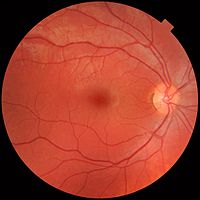
Photo from wikipedia
Importance Examinations for retinopathy of prematurity (ROP) are typically performed using binocular indirect ophthalmoscopy. Telemedicine studies have traditionally assessed the accuracy of telemedicine compared with ophthalmoscopy as a criterion standard.… Click to show full abstract
Importance Examinations for retinopathy of prematurity (ROP) are typically performed using binocular indirect ophthalmoscopy. Telemedicine studies have traditionally assessed the accuracy of telemedicine compared with ophthalmoscopy as a criterion standard. However, it is not known whether ophthalmoscopy is truly more accurate than telemedicine. Objective To directly compare the accuracy and sensitivity of ophthalmoscopy vs telemedicine in diagnosing ROP using a consensus reference standard. Design, Setting, and Participants This multicenter prospective study conducted between July 1, 2011, and November 30, 2014, at 7 neonatal intensive care units and academic ophthalmology departments in the United States and Mexico included 281 premature infants who met the screening criteria for ROP. Exposures Each examination consisted of 1 eye undergoing binocular indirect ophthalmoscopy by an experienced clinician followed by remote image review of wide-angle fundus photographs by 3 independent telemedicine graders. Main Outcomes and Measures Results of both examination methods were combined into a consensus reference standard diagnosis. The agreement of both ophthalmoscopy and telemedicine was compared with this standard, using percentage agreement and weighted &kgr; statistics. Results Among the 281 infants in the study (127 girls and 154 boys; mean [SD] gestational age, 27.1 [2.4] weeks), a total of 1553 eye examinations were classified using both ophthalmoscopy and telemedicine. Ophthalmoscopy and telemedicine each had similar sensitivity for zone I disease (78% [95% CI, 71%-84%] vs 78% [95% CI, 73%-83%]; P > .99 [n = 165]), plus disease (74% [95% CI, 61%-87%] vs 79% [95% CI, 72%-86%]; P = .41 [n = 50]), and type 2 ROP (stage 3, zone I, or plus disease: 86% [95% CI, 80%-92%] vs 79% [95% CI, 75%-83%]; P = .10 [n = 251]), but ophthalmoscopy was slightly more sensitive in identifying stage 3 disease (85% [95% CI, 79%-91%] vs 73% [95% CI, 67%-78%]; P = .004 [n = 136]). Conclusions and Relevance No difference was found in overall accuracy between ophthalmoscopy and telemedicine for the detection of clinically significant ROP, although, on average, ophthalmoscopy had slightly higher accuracy for the diagnosis of zone III and stage 3 ROP. With the caveat that there was variable accuracy between examiners using both modalities, these results support the use of telemedicine for the diagnosis of clinically significant ROP.
Journal Title: JAMA Ophthalmology
Year Published: 2018
Link to full text (if available)
Share on Social Media: Sign Up to like & get
recommendations!